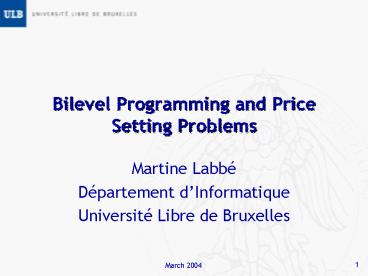Bilevel Programming and Price Setting Problems - PowerPoint PPT Presentation
1 / 31
Title:
Bilevel Programming and Price Setting Problems
Description:
Universit Libre de Bruxelles. March 2004. Seminar - ECARES. 2. In collaboration with ... M. Labb , P. Marcotte, and G. Savard (1998), A bilevel model of ... – PowerPoint PPT presentation
Number of Views:376
Avg rating:3.0/5.0
Title: Bilevel Programming and Price Setting Problems
1
Bilevel Programming and Price Setting Problems
- Martine Labbé
- Département dInformatique
- Université Libre de Bruxelles
2
In collaboration with
- Luce Brotcorne, U. de Valenciennes
- Sophie Dewez, ULB
- Patrice Marcotte, CRT, Montréal
- Gilles Savard, GERAD, montréal
3
Basic References
- M. Labbé, P. Marcotte, and G. Savard (1998), A
bilevel model of taxation and its application to
optimal highway pricing, Management Science, Vol.
44, 1608-1622. - M. Labbé, M., P. Marcotte and G.Savard (2000), On
a class of bilevel programs, in Nonlinear
Optimization and Related Topics, G. Di Pillo and
F. Giannessi (eds.), Kluwer,183-206.
4
Bilevel Program
where
5
Adequate Framework for Stackelberg Game
- Leader 1st level,
- Follower 2nd level.
- Leader takes followers optimal reaction into
account.
6
Adequate Framework for Principal/Agent Model
- Principal first level,
- Agent second level
- Principal wants to delegate task to Agent against
reward. - Principal optimizes his utility s.t.
- Agent accepts task
- Agent performs optimally
7
Adequate framework for Price Setting Problem
- 1st level set taxes on some activites
- 2nd level selects activities among taxed and
untaxed ones to minimize operating costs
8
Price Setting Problem with linear constraints
(PSP)
nonempty and bounded
nonempty
9
A 2-dimensional example
10
The profit function
T6
T4
T5
T1
T2
T3
11
Reformulation
12
Reformulation-contd
Dual of lower level with infinite taxes
Lower level with zero taxes
13
Price setting problem
- Bilinear bilevel program
- Reformulation as linear bilevel program
- Reformulation as bilinear single level program
14
Toll setting problem
- Network with taxed arcs (A1) and non taxed arcs
(A2). - Costs on arcs
- K commodities (ok, dk, nk)
- Routing on cheapest (costtoll) path
- Maximize total profit
15
Toll Setting Problem
16
Additional References - Toll Optimization
- L. Brotcorne, M. Labbé, P. Marcotte, and G.
Savard (2001), A Bilevel Model for Toll
Optimization on a Multicommodity Transportation
Network, Transportation Science, Vol. 35,
345-358. - L. Brotcorne, M. Labbé, P. Marcotte and G.
Savard (2003), Joint Design and Pricing on a
Network, submitted - S. Dewez, Toll Optimization problems
Formulations and Solutions algorithms, Ph.D.
dissertation, June 2004.
17
Example
UB on T1 T2 SPL(T ?) - SPL(T0) 22 - 6 16
T23 5, T45 10
18
Flow not assigned to SP(T0)Example
T23 T45 T15 7, profit 7
19
Example with negative toll
20
Toll Setting problem
- Strongly NP-hard even for only one commodity.
- Polynomial for one commodity if lower level path
is known - Polynomial for one commodity if toll arcs with
positive flows are known - Polynomial if one single toll arc.
- Polynomial algorithm with worst-case guarantee of
(logA1)/21
21
Additional References
- P. Marcotte, G. Savard, F. Semet(2004), A bilevel
approach to the travelling salesman problem,
Operations Research Letters, Vol. 32, 240-248. - S. Roch, G. Savard, P. Marcotte, Design and
analysis of an approximation Stackelberg network
pricing, submitted.
22
One toll arc - algorithm
- For each k, compute UB(k) on profit(k) if k uses
toll arc - UB(1) ? UB(2) ? ?UB(K)
- Ta UB(i), with
23
Toll setting - reformulation
24
Linearize Tak Taxak
25
(No Transcript)
26
Solution approach
- Formulate TSP as MIP
- Tight bound M on tax, if arc used and if arc not
used, very effective - Add valid inequalities to strengthen LP relaxation
27
The shortest path graph model
- Routing on shortest path in original graph
- Routing in SPGM
28
A graph and its SPGM
29
Formulation with path variables
30
Computational results
60 nodes 208 arcs
20 commodities
31
Computational results
60 nodes 208 arcs
30 commodities































